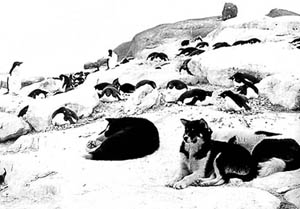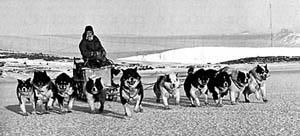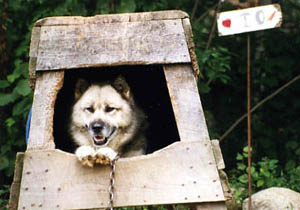In This Issue...
*
F.I.D.O.: Daniel Annanack
*
F.I.D.O.: Mark Brazeau and Qimmiit Utirtut
*
Wolf Problems in Kuujjuaq
*
Inuit Dogs of Mawson Station
*
Differences in Mushing: Greenland and Arctic Canada, Part II
*
Inuit Produced Information Resources
*
In the News
*
Book Review: 1000 Days with Sirius
*
Product Review: 3Mô Precise Skin Stapler
*
IMHO: A Time for Action
Navigating This
Site
Index of articles by subject
Index
of back issues by volume number
Search The
Fan Hitch
Articles
to download and print
Ordering
Ken MacRury's Thesis
Our
comprehensive list of resources
Talk
to The
Fan Hitch
The Fan
Hitch home page
ISDI
home page
Editor's/Publisher's Statement
Editor: Sue Hamilton
Webmaster: Mark Hamilton
The Fan Hitch welcomes your letters, stories, comments and suggestions. The editorial staff reserves the right to edit submissions used for publication.
Contents of The Fan Hitch are protected by international copyright laws. No photo, drawing or text may be reproduced in any form without written consent. Webmasters please note: written consent is necessary before linking this site to yours! Please forward requests to Sue Hamilton, 55 Town Line Rd., Harwinton, Connecticut 06791, USA or mail@thefanhitch.org.
This site is dedicated to the Inuit Dog as well as related Inuit culture and traditions. It is also home to The Fan Hitch, Journal of the Inuit Sled Dog.

Peaceful coexistence Photo: P. Moonie
Photo used by permission of Kangaroo Press, all rights reserved
Inuit Dogs of Mawson Station
by Frank Hashek
Beech Grove, Indiana, U.S.A.
History
Teams of Inuit Sled Dogs served Australia's National
Antarctic Research
Expeditions (ANARE) from 1950 through 1992. The dogs
worked at all of the
various stations established by ANARE. Mawson
Station, named after
noted Australian explorer Sir Douglas Mawson, was the main
base. Other
stations, including Casey and Davis, were established to
better explore
and research other areas of the continent.
Originally, the dogs were called Labrador Huskies and Greenland Huskies, named after their region of origin. The Australian team originated from the French team. In 1947, the French received Labrador dogs from the British as well as some dogs directly from Greenland. Heavy pack ice prevented the French from landing their dogs on the Antarctic continent during the winter of 1948-1949. Rather than return the dogs to Europe on a long sea voyage, the French arranged with Sir Douglas Mawson to over-winter them in Australia. Due to stringent Australian quarantine laws, the dogs were received by the Melbourne Zoo, over-wintered there and returned to Antarctica. The agreement between the two countries provided that any pups born at the zoo, as well as any dogs unwanted by the French expedition would become the property of ANARE.
In December of 1949, the French picked up their dogs at the Melbourne Zoo and transported them to Antarctica. In January 1950, the 24 dogs remaining began their journey to Australia's station on Heard Island.
A Dog's Life in Antarctica
The dogs lived on tie-outs, without houses. While this may
sound unusual,
a house could become a liability for the dog, as it would
be quickly buried
in snow during frequent storms. The dogs created their own
shelters in
the snow.
Generally, one person was designated to be responsible for the care and training of the dogs. This dog handler would try to manage the breeding as well in order to produce only the number of pups needed to sustain the team. In the selection of the sire and dam he would also try to maintain genetic diversity and to produce dogs with the desired traits. Occasionally, a random breeding would occur. Given the initial small size of the pack, however, inbreeding eventually took place. Reportedly, there were occasions when additional dogs were introduced to enhance the gene pool. This included the introduction of dogs from Greenland and an Alaskan Malamute from Australia.
When a female was close to whelping, she would be brought inside. After giving birth, introduction of the pups to the outdoor environment was largely on the mother's timetable. She would usually begin taking the pups out individually for a brief period. The time outdoors would increase until the mother had the entire litter outdoors for extended periods. At this point the dog handler would move the family outdoors permanently.
Nutrition for the dogs initially consisted mostly of seal meat. Disabled or elderly seals were harvested, cut up into meal-sized pieces and allowed to freeze for later feedings. This was a natural diet for the dogs and did not require harvesting large numbers of seals. On occasion, the dogs would catch a stray penguin that wandered into their living area. While away from the base station on an expedition, the dogs also might kill and eat an occasional penguin.
As environmental advocacy groups became more involved in Antarctic issues, the feeding program evolved into a strictly commercial diet. This food, supplemented with dietary fats and other nutrients, was processed into meal-sized blocks and frozen prior to shipment from Australia.

Dogs and Dogman. Lars Larsen and
team.
Photo: L. Larsen
Photo used by permission of Kangaroo
Press, all rights
reserved
Working Life of the Mawson Dogs
Sled dogs were invaluable for safety, efficiency and
reliability of
transportation when conducting wildlife (penguins and
seals), weather or
geographical research away from the base station. When
talking about their
reliability, one of the dog handlers commented that you
never had to adjust
a carburetor on a dog. They saved the lives of their
masters on more than
one occasion.
The dogs began training in harness at an early age, often when they were of adult size, but not of full physical maturity. This, as well as the severity of the climate, caused most of the dogs to become afflicted with arthritis and unable to work extensively by the time they reached about eight years-old. Aged and feeble dogs as well as pups not suited for development as working dogs were culled from the pack.
Depending on the needs of the mission, dogs would be run in either fan hitch or in a tandem hitch configuration. Away from base camp, the dogs often assured the safe return of the researchers by their tireless work pulling the sledges. They were very knowledgeable of where the trails were, frequently keeping the researchers from losing their way, particularly on return trips. The dogs were adept at finding and following safe trails as well. Lead dogs seemed to have an ability to read the snow and avoid hidden crevasses. When it was necessary to cross a crevasse, the dogs would bunch up, creating slack in their lines and then leap the crevasse in pairs.
Many of the dog handlers observed that the dogs enjoyed a good fight and often seemed to prefer fighting to eating. This would often lead to rivalries with some dogs remembering scores they had to settle with other particular dogs. This could be a little unnerving on the trail when more than once researchers had to play veterinarian. For example, Arne and Bear had an ongoing feud. Arne was a large, strong dog of traditional ISD lineage. He was named after Arne Sorensen, captain of one of the ships serving between Antarctica and Australia. Bear was a very large, stocky and very strong dog of ISD and (recent) Malamute lineage. Bear was a "dirty fighter" and would usually try to attack another dog by taking a hold of its mouth. On one particular expedition, a fight took place between Arne and Bear. Bear did his usual mouth hold resulting in a large and nasty tear in Arne's lip. The researchers sedated Arne with supplies from their medical kit and sewed his lip back together during stormy, sub-zero weather. This is a good illustration of one reason why the Inuit Sled Dog should not be cross bred with other breeds. The instincts and developed behavior for maintaining the pack hierarchy were not the same in Bear as the other dogs. The normal way of terminating a fight would be for the winning dog to take a neck hold and for the subordinate dog to submit to the dominant dog.
The Mawson Dogs Leave Antarctica
Led by Greenpeace, environmental advocacy groups helped
bring about
a treaty calling for all non-native species, excepting
humans, to be removed
from the Antarctic continent. The rationale was that
non-native species,
i.e. dogs, disrupted the environment, preying on native
wildlife for food
and potentially spreading disease. In an effort to
mitigate and prevent
any of these problems, a number of years prior to the
removal of the dogs
ANARE stopped using seals as food and brought in a
commercial based diet.
ANARE also fenced the dog yard to keep the dogs and
penguins separate.
ANARE established a protocol for collection and disposal
of the dog feces
to prevent any chance of spreading disease. Nonetheless,
the agreement
was reached to remove all dogs from Antarctica.
Initially, the plan was to euthanize the dogs while in Antarctica. However, a movement began to repatriate the dogs to Australia. After some research and political maneuvering, the Australian government decided to donate the dogs to educational based projects in the United States. Four of the oldest dogs were permitted to retire with former ANARE expeditioners in Australia. Five dogs were sent to explorer Paul Schurke's Wintergreen Dogsledding Lodge in Ely, Minnesota. Seventeen dogs went to Voyageur Outward Bound School (VOBS), also in Ely. The dogs traveled by mushing and helicopter from the Mawson Station to a ship waiting off Antarctica, then sailed to Australia were they were flown to Los Angeles and finally trucked to Minnesota.
After working in Minnesota, at least one of the dogs, Io, was retired to Australia. Other Outward Bound dogs retired with various students and faculty who continued to mush with them or cared for them as non-working dogs in Ely and elsewhere in the United States.

Io in retirement, Voyageur Outward Bound
School, Ely,
MN Photo: Hamilton
The Last Husky: VHS format only, a documentary about the journey of the dogs from Mawson Station to Minnesota. Available from the producer, Jonathan Chester: [http://www.extremeimages.com/books/video.html]
Paul Schurke's Wintergreen Dogsledding Lodge
Lawrence Morris's homepage: Mr. Morris has cared for several retired Mawson dogs and has some good photos of them.
Voyageur Outward Bound School: All of the Mawson dogs are now retired. VOBS still has at least one dog that is an offspring of one of the Mawson dogs. If you have not had the opportunity to mush a team of dogs, this is a good place to gain some solitude and learn about dogsledding on a winter expedition.
Huskies In Harness, ISBN 0-86417-726-7, edited by Shelagh Robinson, published by Simon and Schuster's Australian branch. This is a compilation of writings by members of the ANARE team about their memories of and experiences with the Mawson dogs. The book has an appendix that includes some, although incomplete, information on the breeding and lineage of the Mawson dogs. Simon and Schuster has graciously allowed the use of two photographs from Huskies in Harness for this article. The book is out of print and the publisher indicated no plans to reprint. Used copies can often be found through Amazon.com and its affiliate sites in Canada and the United Kingdom.
Oscar, The True Story Of a Husky, ISBN 0-9588161-1-5 (paperback edition) is a fun and interesting read. It was written by Commander Nils Lied, a former ANARE expeditioner. While based on fact, it seems that Commander Lied may have taken some liberties as the breeding and lineage information in Huskies In Harness does not support his statement about how prolific Oscar was as a sire. This book is out of print, but used copies can occasionally be found through Amazon.com and its affiliate sites in Canada and the United Kingdom. There is a Reader's Digest condensed edition and there may be a hardcover edition as well.
Editor's note: Misty, born at Mawson Station on 08/10/92, was retired to VOBS two years later and then retired from VOBS to Frank Hashek's care in August 2003.